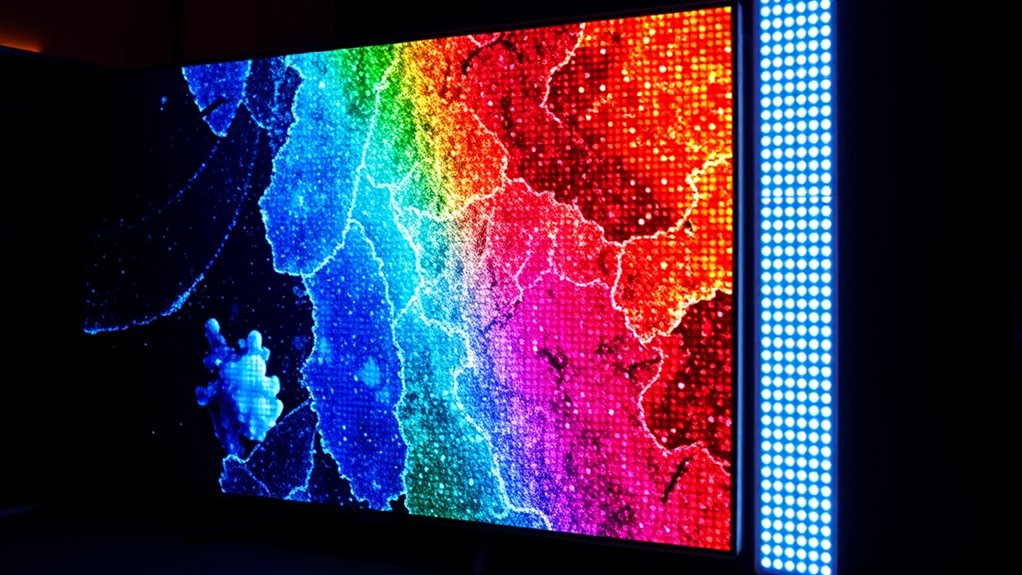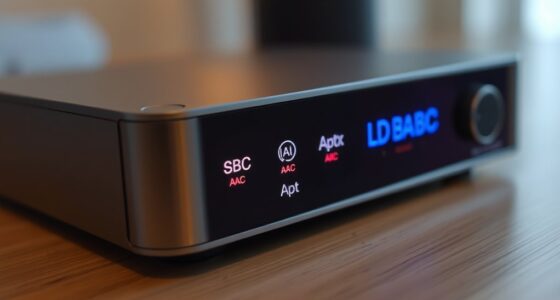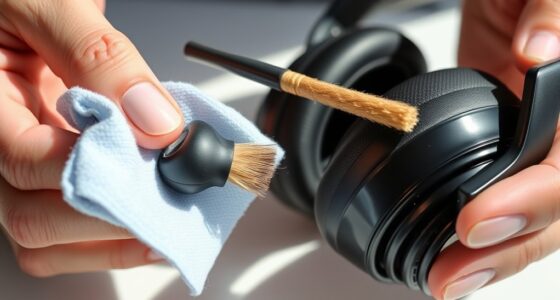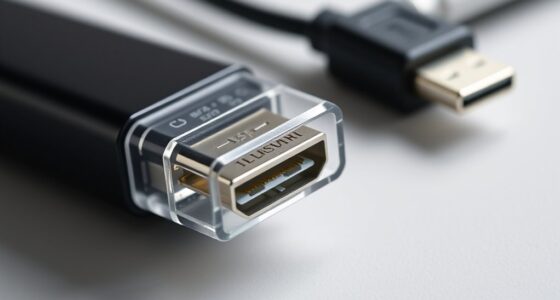OLED, QLED, and LED displays each have unique strengths. OLED screens emit their own light, offering deep blacks, vibrant colors, and flexible designs like curves and foldables. QLED panels use quantum dots to enhance brightness and color accuracy, making them great for bright environments. Traditional LED screens rely on backlighting and can vary in picture quality depending on the technology used. Exploring further will help you understand which type fits your needs best.
Key Takeaways
- OLED displays emit their own light using organic compounds, enabling deep blacks and vibrant colors.
- QLED screens use quantum dots to enhance brightness and expand color range, especially in well-lit environments.
- LED screens rely on backlit technology with diodes to produce images, offering versatility and energy efficiency.
- OLEDs are flexible, allowing curved and foldable designs, while QLEDs excel in brightness and color accuracy.
- Understanding these differences helps choose the best display type based on viewing environment and design preferences.
Understanding OLED Technology
OLED technology stands out because each pixel emits its own light, allowing for vibrant colors and true blacks. This is possible thanks to organic compounds that glow when an electric current passes through them. These organic materials are key to creating the bright, sharp images OLED displays are known for. One major advantage is the ability to produce flexible panels, thanks to the thin, bendable nature of the organic layers. This flexibility opens up new design possibilities, like curved or foldable screens. Unlike other display types, OLEDs don’t require a backlight, which makes them thinner and more energy-efficient. As a result, you get stunning visuals with deep blacks and rich colors, all in a sleek, lightweight package. Additionally, color accuracy is enhanced by the precise control of individual pixels, further improving image quality.
Exploring QLED Displays
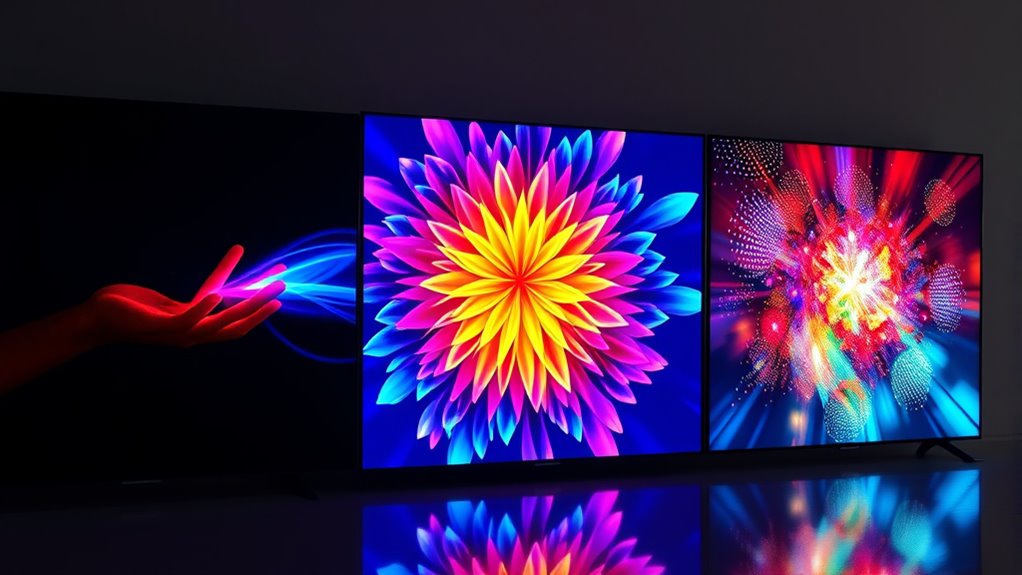
QLED displays enhance traditional LED technology by using a quantum dot layer that boosts brightness and color accuracy. This quantum dot augmentation allows for more vibrant visuals and improved HDR performance, making images pop with vivid detail. Unlike standard LEDs, QLED screens incorporate advanced backlight technology that provides uniform illumination and higher brightness levels. The quantum dots convert the backlight’s blue light into precise colors, resulting in richer reds, greens, and blues. This combination of quantum dot enhancement and sophisticated backlighting ensures a wider color gamut and better contrast. As a result, QLED displays deliver a stunning visual experience, especially in bright environments. You get a brighter, more colorful picture that outperforms traditional LED screens without the burn-in risks associated with OLEDs.
The Basics of LED Screens
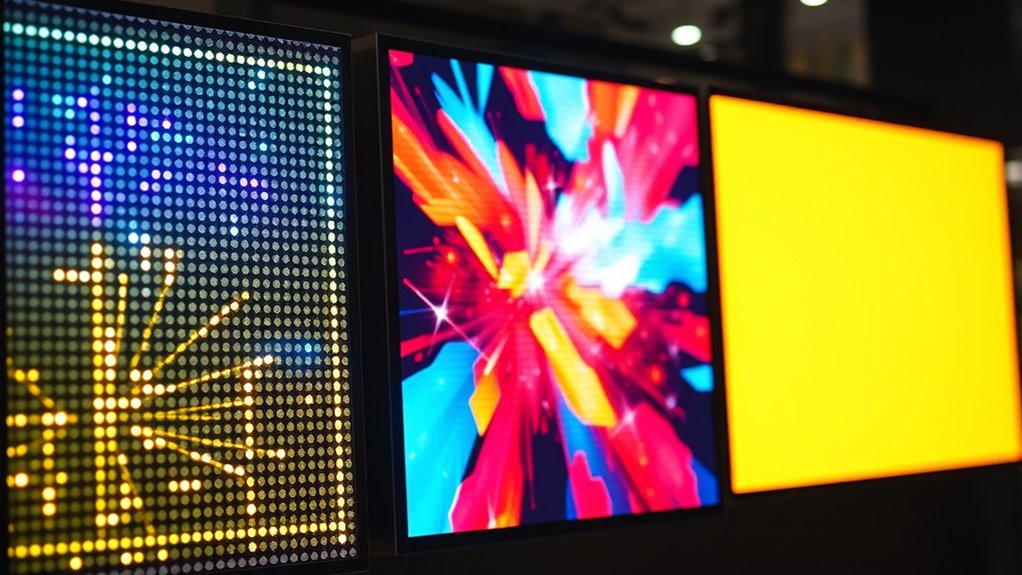
LED screens operate by passing an electric current through tiny light-emitting diodes to produce images, making them a popular choice for modern displays. They rely on backlight technology, where LEDs behind the screen illuminate pixels to create visuals. This setup allows for slim designs and energy efficiency. Color accuracy is a key advantage of LED screens, as high-quality models can display vibrant, true-to-life colors. Variations in backlight technology, like edge-lit and direct-lit configurations, impact brightness and contrast. LED screens are versatile, suitable for everything from TVs to monitors. Their ability to deliver sharp images with rich color reproduction makes them a preferred choice for many users. Understanding these basics helps you appreciate how LED screens enhance your viewing experience. backlight technology is a crucial factor in determining display quality and performance.
Frequently Asked Questions
How Long Do OLED Displays Typically Last Before Image Retention Occurs?
You can expect OLED displays to last around 30,000 to 50,000 hours before image retention or burn-in might become noticeable. With proper care, their lifespan durability remains strong, but prolonged static images can increase the risk of image retention. To maximize longevity, avoid leaving static images on screen for extended periods and consider using screen savers or pixel shift features. Proper maintenance helps make sure your OLED display stays vibrant longer.
Are QLED Screens More Energy-Efficient Than Traditional LED Displays?
QLED screens are generally more energy-efficient than traditional LED displays because they use quantum dot technology to enhance brightness and color while reducing energy consumption. This means you’ll enjoy better power efficiency, especially during bright scenes or high dynamic range content. By choosing a QLED, you can save on energy bills and extend your device’s lifespan, making it a smarter, more sustainable viewing option.
Can LED Screens Be Made Flexible or Curved?
Did you know that flexible screens are now a reality? Yes, LED screens can be made flexible or curved thanks to advanced curved display technology. You can enjoy immersive viewing with screens that bend and curve to fit your space or preferences. Manufacturers are increasingly using flexible LED panels, making it possible to create curved displays that are lightweight, durable, and perfect for innovative design ideas or unique viewing experiences.
What Are the Environmental Impacts of Manufacturing OLED Versus QLED Panels?
You should know that manufacturing OLED panels has a higher environmental impact due to the use of rare organic materials and energy-intensive processes, which pose recyclability challenges. QLED panels, on the other hand, often involve more sustainable manufacturing practices and use inorganic materials that are easier to recycle. However, both types still face environmental concerns, so choosing more eco-friendly production methods can help reduce their impact.
How Do Maintenance and Repair Costs Compare Across OLED, QLED, and LED Screens?
You’ll find that maintenance and repair costs vary, with LED screens generally being easier and cheaper to fix due to widespread availability of replacement parts and simpler repair complexity. OLED and QLED panels can be more expensive and complex to repair, often requiring specialized skills and parts. If your screen suffers damage, expect OLED and QLED to cost more to repair, especially if the display panel itself needs replacement.
Conclusion
Now that you understand OLED, QLED, and LED displays, imagine each screen as a window into different worlds. OLEDs glow like stars in the night sky, offering deep blacks and vibrant colors. QLEDs shimmer like a city skyline, bright and vivid. LEDs, like steady lanterns, provide reliable illumination. Choosing the right display is like selecting the perfect lens for your vision—each offers a unique perspective, shaping how you see and experience your favorite content.
